“Nandor Fodor and the Talking Mongoose” is a feature film based on a real story, real in the sense that for a while back in 1931, on the British Crown Dependency the Isle of Man, some people claimed that there was a mysterious creature something like a mongoose who spoke like a human. Some scientists came to investigate. This movie is less about solving that mystery than the central question we still passionately debate in today’s arguments about school curricula and fake news: How do we know what we know, and how is that different from what we believe?
Simon Pegg plays a real-life expert on parapsychology, the Austrian-American Nandor Fodor, with Minnie Driver as his long-time assistant, Anne. We first see him interviewed about the film’s (and perhaps life’s) central question: What is reality? He says he can see a man with a beard in the corner of the room. The journalist and cameraman cannot. Neither can we—until, for a millisecond, we can. Is Fodor being provocative to make a point? Or is writer/director Adam Sigal? Is the basis of reality universally observable truth and logic? Or, isn’t it true that most people believe in something that is neither, from a higher power to the idea of luck to whatever makes us decide that one person is uniquely suitable as a soulmate to whatever conspiracy theory goes viral online?
Fodor receives many requests for help from people who believe they have had paranormal experiences. Just one captures his attention because it comes from another distinguished scientist, Dr. Harry Price (Christopher Lloyd, his breathy, hollow voice just right for the scientist who finds all his assumptions challenged). Price describes a creature known as Gef (pronounced Jeff), who lives with the Irving family, well-to-do farmers. Hearing the resolutely empirical Price suggest that this creature might be real makes Fodor decide to see for himself. When Price calls him a skeptic, Fodor demurs. But Price compares him to the magician and medium-debunker Houdini. “You investigate supernatural occurrences under the guise of understanding why humans project these phantasms into reality, why they are incapable of letting go of these delusions, as you call them.” Fodor does not object to the term “delusions” and tells Anne, after reading Mr. Irving’s detailed journal, “It rivals the Arabian Nights for the fantastic improbabilities it contains.”
Mr. Irving comes to meet them, and he is so genial and matter-of-fact in describing the creature that he makes Gef seem almost as ordinary as the dogs. Fodor is certain it cannot be real despite many local witnesses. He is relieved that Irving’s employee, Errol (Gary Beadle), does not believe Gef exists. The most compelling evidence that it is a hoax is the Irving daughter, an acknowledged ventriloquist. But then, something happens so far outside Fodor’s understanding of reality that he is deeply shaken. Anne, who observes the daughter’s ventriloquism expertise, is willing to consider the possibility of a mongoose that talks and understands human conversation and may have memorized a Yeats poem before it was published. We do hear Gef’s voice, and it is exceptionally well-chosen: writer Neil Gaiman.
There is a lovely, timeless quality to the world production designer Andrew Holden-Stokes and cinematographer Sara Deane have created. The scenes in London are golden-hued, with leather and wood that seem to have been unchanged for decades and expected to survive for centuries. The rural settings on the Isle of Man are lush and vibrant. The Irvings are prosperous. They have a car to carry visitors over the bumpy dirt roads, but otherwise, their home and farm have no emblems of recent technology.
This is not a gotcha movie. Sigal is not trying to answer questions about whether Gef existed or who was behind the story. Instead, it explores how we discern reality and what we hope to get from our judgment about what is real. It is not a coincidence that the fascination with Gef was 14 years after the Cottingly Fairy hoax that severed the once-close friendship of believer Sir Arthur Conan Doyle and skeptic Harry Houdini (see the excellent film “Fairy Tale: A True Story”). Times of tragedy and upheaval give rise to hopes around stories of the supernatural.
This film is in conversation with existential issues of meaning and with contemporary concerns about the failures of institutional authority, though is not always clear what he wants us to think about it. Perhaps he is on the side of Errol, who says that letting people believe in Gef is more important than proving them wrong. “People love that mongoose,” he tells Fodor. “The one that does not exist.” “Yes.” [Note: At the very end of the credits, there are some scenes of the cast members trashing the director.]
Now playing in theaters.




















